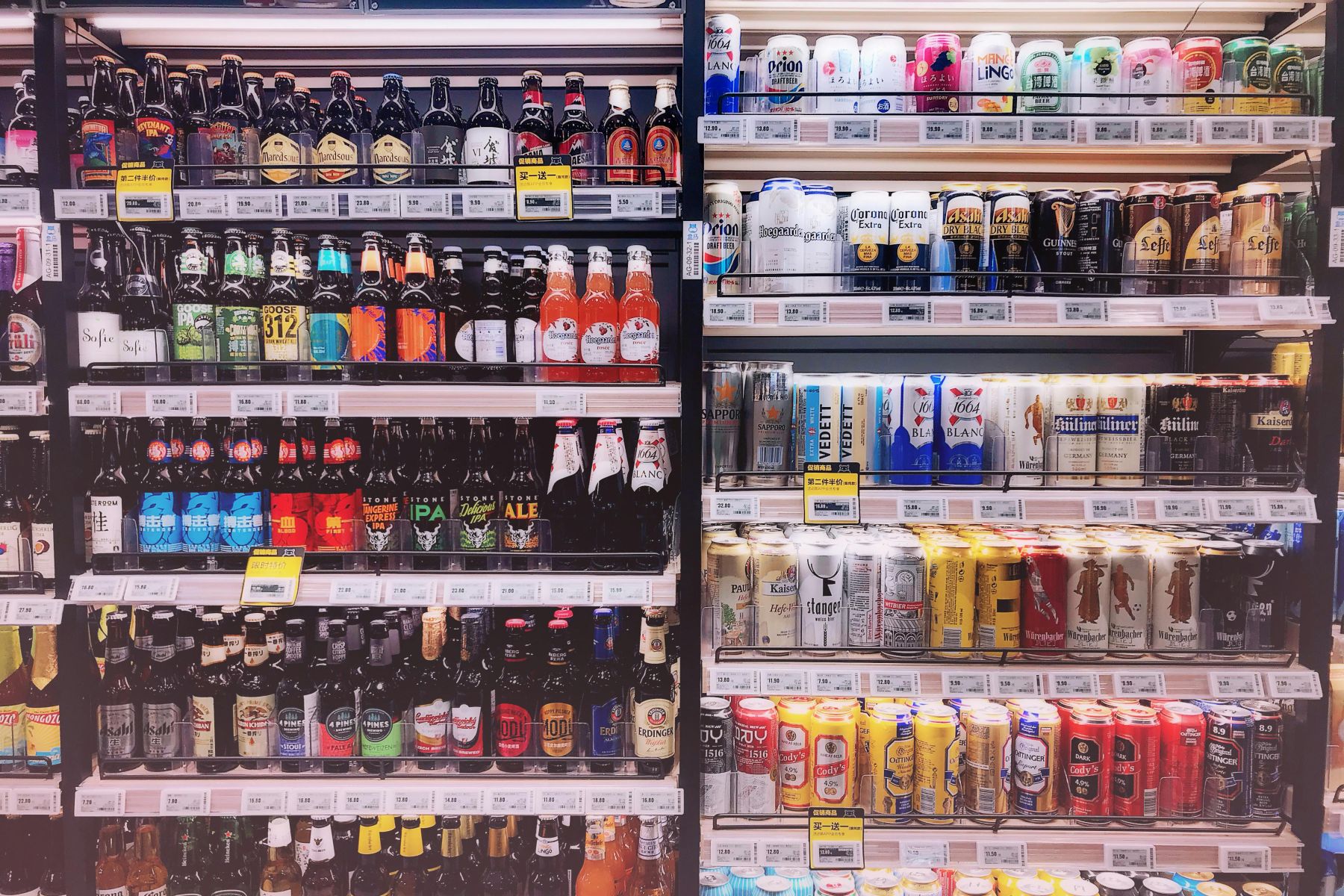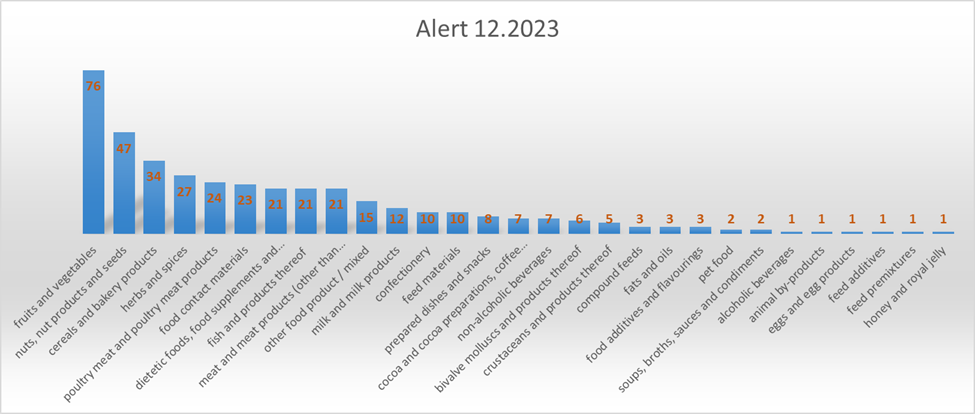In Q2 2025, the EU’s Rapid Alert System for Food and Feed (RASFF) issued 1237 recall notifications, including 1143 related to food, 34 concerning food contact materials, and the remainder involving animal feed. Compared to Q1, the number of alerts saw a slight increase, but the overall risk trend remained unchanged: plant-based foods continued to account for the highest number of alerts.
According to statistics, fruits and vegetables remained the most frequently flagged category with 214 cases, followed by nuts and nut products with 176 alerts, and herbs and spices with 104 alerts. Other notable categories included poultry meat (101) and cereals and bakery products (98). The main hazards reported included pesticide residues, natural toxins, heavy metals, pathogenic microorganisms, undeclared allergens, foreign bodies, unauthorized additives, antibiotic residues, and the use of ingredients not approved by the EU.
The hazard chart shows chemical contamination as the leading cause with 371 alerts, followed by microbiological hazards with 270 cases, and pesticide residues with 203 alerts.
Details of the reported hazards:
- Contaminants:
- This continued to be the most reported hazard group, with approximately 371 cases recorded. Nuts and nut products were the most affected, especially dried varieties such as pistachios, flaxseed, and sesame.
- Common contaminants included aflatoxin B1, ochratoxin A, cadmium, lead, cyanide, and mineral oils (MOSH/MOAH). These substances were mainly found in dried nuts, dried fruits, spices, herbal teas, and vegetable oils.
- Alerts related to pyrrolizidine alkaloids continued to appear in spices and herbal teas, indicating that risks from natural toxins remain insufficiently controlled.
- Substances such as glycidyl esters, 3-MCPD, and benzo(a)pyrene were reported more frequently than in Q1, especially in vegetable oils and processed foods.
- Erucic acid residues in mustard seeds from Russia continued to be flagged in Q2, although the number of cases declined compared to the previous quarter, suggesting initial improvements in raw material control.
- Microbiological hazards:
- Q2 2025 recorded 270 alerts, confirming that microbiological hazards remain the second most common risk after chemical contamination.
- Salmonella accounted for a high proportion of alerts, with various strains such as Enteritidis, Infantis, Newport, Typhimurium, and Senftenberg found not only in poultry meat but also in spices and dietary supplements.
- Listeria monocytogenes ranked second, detected in salmon, cheese, cold cuts, and ready-to-eat vegetables, reflecting ongoing risks of cross-contamination in chilled production environments.
- Other microorganisms such as STEC (toxin-producing E. coli), Vibrio spp., Clostridium botulinum, Bacillus cereus, and Norovirus were also reported, particularly in seafood, fresh produce, and mixed foods.
- Poland remained the hotspot with the highest number of alerts, followed by Germany, France, Italy, the Netherlands, and Türkiye.
- Pathogenic microorganisms were found not only in animal-based products but also in plant-based and mixed foods, indicating cross-contamination risks and insufficient hygiene control throughout the production chain.
- Pesticide residues:
- Banned substances in the EU such as chlorpyrifos, acephate, methamidophos, carbendazim, permethrin, hexaconazole, and picoxystrobin continued to be frequently detected in vegetables, tea, spices, and cereal products.
- Notably, Q2 still recorded the presence of ethylene oxide (7 cases) in spice products imported from India, Georgia, and the UK.
- The high number of alerts related to pesticide residues suggests that source-level inspections remain insufficient, especially for products from Asian and South American countries.
- Allergens:
- The most affected category was cereals and bakery products.
- Alerts were mainly due to missing declarations on labels for substances such as milk, gluten, sesame, eggs, soy, and celery.
- This is a common but avoidable issue if businesses thoroughly review labeling procedures and allergen control during production.
- Some alerts involved undeclared sulfur dioxide, particularly in pickled products and dried fruits. According to EU regulations, if sulphite levels exceed 10 mg/kg, it must be declared as an allergen on the label.
- Food additives:
- A total of 29 alerts related to food additives were recorded in Q2, mainly due to the use of unauthorized additives or exceeding permitted levels.
- The most frequently flagged substances included benzoic acid (E210), sorbic acid (E200), and titanium dioxide (E171).
- Countries with frequent violations included Thailand, the United States, Bangladesh, and Türkiye.
- Affected products were diverse, but mainly included mixed foods, cereals, confectionery, and non-alcoholic beverages.
- Common issues included the use of banned additives, exceeding limits, and missing declarations on labels.
- Antibiotics:
- Nitrofuran (AOZ), metronidazole, and Leucomalachite green continued to be detected in seafood, mainly from India and Ukraine. These substances are banned in the EU due to toxicity concerns.
- However, only 5 alerts were recorded this quarter, indicating a low frequency of violations, though continued monitoring is necessary.
- Novel foods:
- The most affected category was dietary supplements and functional foods.
- Several ingredients not approved by the EU were detected, including CBD, zeolite, fly agaric, berberine, and Griffonia simplicifolia.
- Businesses should verify the EU’s approved novel food list before developing new products.
- Foreign bodies:
Multiple cases of metal, plastic, glass, and wood fragments were found in products such as yogurt, confectionery, salads, and canned foods.
These physical hazards are often overlooked during final inspections before export.
- Other hazards: 187 alerts
- The most affected category was dietary supplements and functional foods.
- Common issues included mislabeling, incorrect batch information, lack of traceability, use of unverified ingredients, and import regulation violations.
- This diverse group of alerts reflects systemic challenges in quality management and product documentation.
- Food recall alerts involving products from Vietnam
|
Product |
Hazard |
Frequency |
|
Frozen frog legs |
Nitrofuran (metabolite) furazolidone (AOZ) prohibited substance |
1 |
|
Cinnamon |
Lead (high content) |
2 |
|
Pink pomelo |
Fenobucarb, profenofos unauthorised substance |
1 |
|
Pitahaya |
Permethrin unauthorised substance |
1 |
|
Dragon fruits |
Dithiocarbamate |
1 |
|
Ground ginger |
Aflatoxin B1, Aflatoxin total |
1 |
|
Frozen shrimp |
Sulphite undeclared |
1 |
recurrence of hazards in the alert data from Q1 to Q2 reflects that quality control at the source has not yet been implemented consistently or effectively.
In particular, for products originating from Vietnam, although the number of alerts is not high, the nature of the hazards—such as nitrofuran, lead, and unauthorized pesticides—indicates increasing pressure to comply with EU standards.
To minimize risks and maintain access to the EU market, exporters should focus on the following:
- Establishing source-level inspection procedures, especially for high-risk groups such as pesticide residues, microbiological hazards, and additives.
- Reviewing labeling practices to ensure complete and accurate information on allergens and product composition.
- Verifying packaging and food contact materials in accordance with EU regulations.
- Strengthening traceability systems to improve supply chain transparency and facilitate incident response.
Compliance with technical requirements not only helps reduce recall alerts but is also essential for building credibility and long-term competitiveness in the export market.


